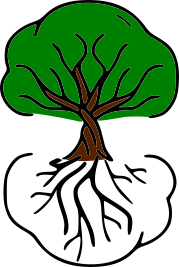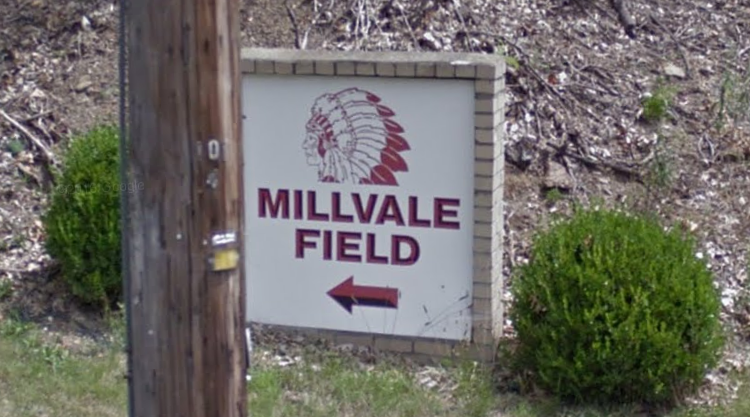A few days ago I had no more excuses. I was settled into my new job, had mostly everything unpacked in my apartment, and the holidays were over; I had to go for a run.
I'm not one of those millennials who enjoy running. The only thing dragging me out of my place that day to do it was my body saying "No more excuses! You need to go for a run!" The problem with this is as soon as I'm on a run, my body seems to break down. Everything from short of breath, ankles throbbing, and heart pounding. Again, I know it is the right thing to do, but I sure do hate doing it.
To help distract myself from all of the complications listed above, I thought I would explore my new neighborhood while exercising. Not ten minutes in did I stumble upon this sign below:
Growing up I would not have given this a second notice. But after living and learning with someone with a connection to a tribe, I saw with new eyes the blatant appropriation. (Side note, this person in my cohort wasn't one of those "I'm 1/16th Cherokee!...I think..." but actually in a tribe). I was also fortunate enough to live near the Lumni Nation during that time as well.
Between my dear friend, the Lumni Nation, and many other discussions during that time, there are two key problems with actions like the sign above that they all taught me;
- Using imagery of someone in their traditional clothes as a symbol for your organization, without the input from people in that culture, is stealing. Even if you think you are honoring by saying the symbol embodies virtues like strength and teamwork, it is not yours to use! As an example, my father having grown up in South East Asia sometimes wears a sarong around the house because that is what he grew up with. Totally acceptable. But if he were to start a business using the silhouette of a Malay person, not ok.
- All of my study of First Peoples growing up told me about "the people who used to live here." Yes, there were people here but now "we" live here, not "them." There may be some tribes out west, but here on the east coast "indians" don't live here anymore. That fails to acknowledge the fact that Europeans killed, moved, and assimilated First Peoples first off. And, more importantly, there are tribal connections still in this land! The Seneca, for example, one of the tribes that originate from the Pittsburgh area (or Dionde:gâ' as they call it), are still alive! And have a website! These are a 21st century people that have lived through much since time immemorial.
So seeing the sign above, I thought "This will be my first civic engagement in Millvale!" After a quick Google search for terms like "Millvale Indians," and "Millvale Warriors," I wrote the following e-mail to my local goverment.
“Hello! My name is Ben Kusserow, and I just moved to Millvale at the beginning of the month. So far my experience here has been wonderful (especially Frank’s pizza, twice!). I wanted to ask about something troubling I saw on my run this evening.
At the intersection of Evergreen Rd and Grossman Ln there is a depiction of a Native American chief wearing a traditional headdress. The sign points toward the Millvale Athletic Association field. After a quick online search I could not find a Millvale specific team named the “Indians,” “Chiefs,” or even “Warriors.”
Being that it doesn’t seem connected to a particular team, and that depiction directly contradicts the diversity initiative of the borough, are there any plans for the renovation of the signs? Before making a public comment I thought I would ask you if there already are plans for it.
Thanks, and looking forward to hearing from you.”
Short, polite, but also showing my distress with the sign. Proud of my first civic engagement in my new neighborhood, I went to bed.
Millvale nestled in the valley, with the Allegheny running to the south. Photo courtesy of Millvale Borough.
The next morning I woke up to an official stating that 1) welcome to Millvale and 2) they forwarded my e-mail to a community member with more knowledge of the subject. The next day, I actually was able to talk to this key community member on the phone. (I always knew smaller communities can be quick, but I had no idea this quick!).
This community member started to tell me about when Millvale had a school in town, they were the Millvale Indians. Once they combined districts with Shaler, they had to change to the Titans. There was also an aspect of a semi-pro football team named the Indians, but they are no longer around.
While I was listening to them talking about this history, I was screaming in my head "I don't care if you claim it is your history, it wasn't right to take it in the first place! And that wrong doing doesn't excuse the continued use of it!"
But I kept listening, and even though there is no team called the "Indians" anymore in Millvale, a few years ago a community keystone member (so even more important than the person I was talking to) made those signs to honor the old teams.
If I were to try to picket the signs, or ask for their removal when I have not lived in this neighborhood for even a month, the town would immediately see me as a threat. Even though the appropriation is wrong, I would have no support. Even worse, I would be viewed as some "gentrifying young liberal who doesn't understand the world."
At the end of my conversation with the community member, I asked what Millvale events I can get involved with. Happily they told me about a local garden where I could take my compost, music days, and even the library.
Sunset over Boston
My time living in the West and New England taught me so much, but especially to stand up and fight for what is right. Now living back in Appalachian country, I am reminded that we are a stubborn people, who do not like being told what to do. When the government told us we could not have alcohol, my ancestors helped smuggle contraband up the Monongahela river during the Whiskey Rebellion.
If I want to see actual change for the better, I need to get involved in the community and try to change it from the inside. Yes, it is slow. Yes, it is tedious. But if done right we can create change that will last years, rather than conflicts that will last geneartions.




